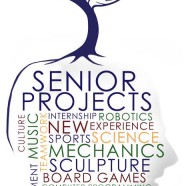
As an idea, Senior Projects seems to have emerged from the fog of the late ’60s and early ’70s. Having made their way proposal writing, finding faculty sponsors, and earning a thumbs-up from overseers, students are free to immerse themselves in something totally different for their final five weeks at Milton. They expand an area of interest, like composing music; or take on a challenge, like building a boat; or try something completely new, like creating a movie. During two days just before graduation, students present their projects—performances, slide shows, installations, lectures and papers. Underclassmen and faculty anticipate and then attend, in venues all over campus. The spring projects that follow reflect the diversity of explorations by the Class of 2013.
Liam McNeil ’13
Liam McNeil interned at Stewie’s Auto & Tire Repair in Randolph, Massachusetts. On a typical day, the garage dealt with fluid leaks, squeaky brakes, broken ACs, dead batteries, and “check engine” lights. On his first day, Liam cleaned up a beat-up car and learned how to change a flat. He eventually progressed to oil changes and replacing spark plugs, and observed more-complicated procedures, such as fuel system repairs.
“My idea was inspired by my grandfather, who owned an auto body shop. I am planning on a career in pharmacy, but I’ve always wanted to learn how to work on cars. I hope to be able to restore cars as a hobby when I am older, and just being able to help out my friends and family with their car problems will be rewarding. The whole project opened my eyes to the skill involved in auto repair, and I am much more appreciative of what mechanics do.”
Skye Russell ’13
Skye Russell’s art installation titled “Beautiful Minds” was displayed in the Arts and Media Center. Her work featured paintings, sculptures and three-dimensional pentagonal spheres relating to the mind.
“Part of my inspiration stemmed from the movie A Beautiful Mind about a schizophrenic man who had a mind that allowed him to see unusual patterns. My recent experiences working with students with learning disabilities, ADHD and students on the autism spectrum, also allowed this idea to take flight. Tutoring is a large part of my life and has greatly influenced my artwork. I know from my own personal experience that having a learning disability can be very stigmatizing, and I believe that having a mentor, seeing success in others, can help build confidence.”
Liane Thornhill ’13
Liane Thornhill’s project also explored learning as well as physical disabilities, culminating in a performance in the Studio Theater titled “We’re All Superheroes: A Theatrical Exploration of our Differences.”
“In my project, I was exploring the art of documentary theater, an art form that I fell in love with after I learned about the actress and playwright Anna Deavere Smith in my performing English class. My topic was Americans with disabilities, and I conducted interviews with people with physical, neurological or emotional disabilities. All of my interviews were amazing experiences, but I narrowed down my performance to five people, including an 18-year-old female with epilepsy and a mother of a son who is nonverbal. I loved doing this project and putting on the performance.”
Jon Esty ’13, Evan Garnick ’13
and Caleb Warren ’13
These three seniors spent hours playing seven different German-style board games multiple times, and then analyzing each game for its degree of strategy, luck, balance and fun. While American board games, such as Monopoly or Life, rely on luck and a strong emphasis on individual play, German-style games, such as Settlers of Catan, are known for a mixture of collaborative and confrontational strategy that requires working with one’s opponents to be successful. Drawing on their research, the boys also developed a proposal for a board game of their own design.
“One of my earliest game memories is playing Settlers of Catan with family friends who had just translated the scarcely known game from German,” says Caleb. “As I watched the game’s popularity explode in the U.S., I continued to learn two to three new German-style games every year. Because the games are so interactive, a player’s strategy has to be adaptive in response to certain moves others players make. This fascinates me, and led me toward wanting to study these German-style games and then create a game with Evan and Jon.”



